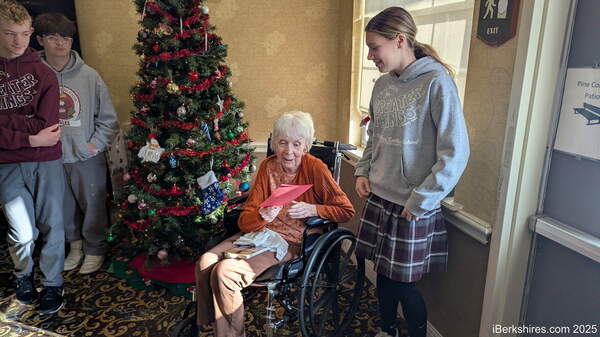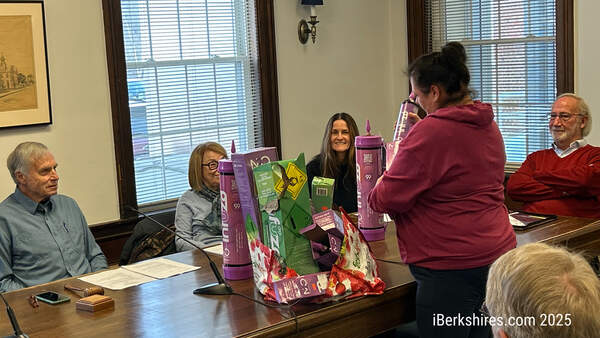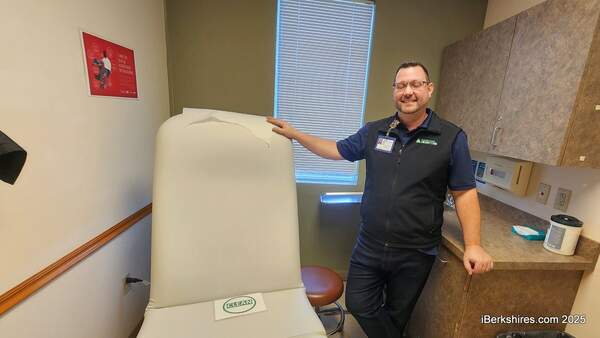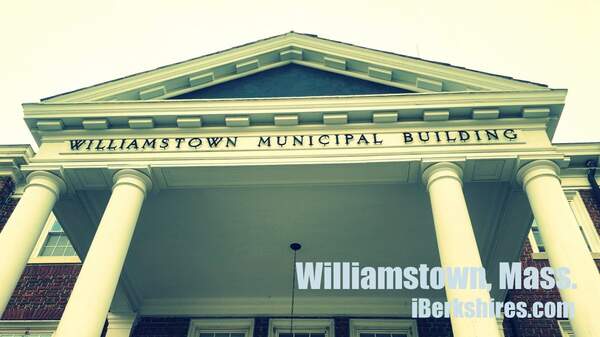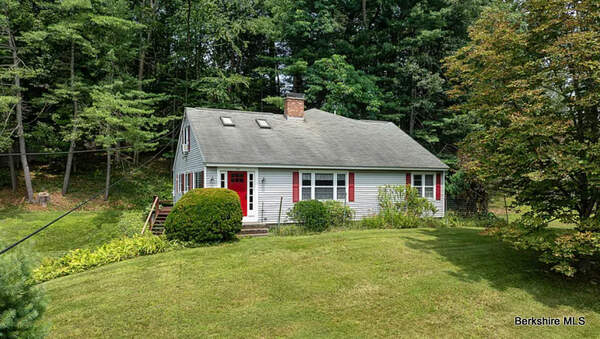The Affordable Housing Committee had recommended the town pursue a deal with Boston's Arch Street Development, which had proposed 60 units on Cole Avenue and 25 on Water Street.
The Selectmen voted to go with the more modest proposal of 46 units submitted by Boston's Women's Institute for Housing and Economic Development and Pittsfield's Berkshire Housing Development Corp.
Chairwoman Jane Allen and Selectmen Ron Turbin and David Rempell voted in favor of the Women's Institute/Berkshire Housing proposal. Tom Sheldon and Jane Patton voted in the minority.
The board on Tuesday took input from members of the AHC and several community members and reinterviewed the competing developers.
Rempell said it was a difficult decision to vote against the wishes of the community that drafted the town's request for proposals, hosted community discussions to craft those proposals, hired consultants, and worked to study and remediate the soils at both town-owned brown-field sites.
"I feel very uncomfortable about voting against their unanimous recommendation because, as everyone's stated, they have worked very hard, and we respect them," Rempell said. "I feel like we're stuck. ... If I support the proposal I think is so much clearer and so much better developed and about which I have a greater feeling of trust, I'm voting against the committee."
Patton said while the Selectmen should not simply rubber stamp the AHC's recommendation, it was ill-advised to disregard the panel's input.
"I'm pretty committed to this notion of asking folks to serve on committees and they give up an awful lot of their time," she said. "There is a 6-0 vote, and these folks are experts at this. ... To fly in the face of this adamant 6-0 vote of these people who have given so much to work and push this forward, I'm troubled that we aren't giving more weight to those opinions."
Though they ultimately chose to split with the panel that it appointed, the Selectmen made it clear they paid close attention to the AHC's deliberations.
Several times on Tuesday, it was noted that the AHC, while unanimous in its selection of Arch Street, had reservations about the developer's proposal.
But for the fact that Arch Street proposed more units and utilized both sites, it appeared likely the committee would have preferred the Women's Institute/Berkshire Housing bid.
"I think we were surprised [by the committee's vote] ourselves after going through the procedure," Affordable Housing Committee Chairwoman Catherine Yamamoto said. "In the end, it was the things that were the most important to us that were the deciding factors."
Those factors were the aggregate number of units -- 85 versus 46 -- and the utilization of the Water Street site.
"I have a long history with affordable housing in Williamstown," AHC Vice Chairman Charles Bonenti told the Select Board. "I've seen over the years the kind of pushback we get to locating affordable housing anywhere in town other than these town-owned properties.
"We all know what happened the last couple of years when we tried to locate housing on Lowry. We're pretty much down to these two sites. For the foreseeable future, this is it. If the Water Street property is not developed [in conjunction with Cole Avenue], developers have told us it's not practical to develop it on its own."
Later in the night, Rempell attempted a note of levity before the Select Board made its final decision.
"I'd like to make a motion we build 40 units of affordable housing on the Lowry property," Rempell deadpanned.
Then, after pausing a beat, he added, "I withdraw the motion."
The Select Board's questions questions for the developers rehashed a few of the concerns raised in their interviews with the AHC. Both proposers again gave assurances that they would be willing to work with abutters to design a housing development that fits into the existing neighborhood.
And Arch Street's principals once again indicated the 60 units on Cole Avenue was a high-end estimate designed to satisfy the request for proposal's emphasis on full utilization of both sites.
But the Selectmen also focused on two issues that were not central to the AHC's deliberations: the relative chances of successful funding for each project and the marketability of up to 85 units of subsidized housing in a town that already more than 50 units scheduled to be built in the next several years -- about 40 at Highland Woods and 13 at Cable Mills. The former is senior housing; the latter is aimed at higher income tenants than either Arch Street's or the Women's Institute's proposals.
On the issue of fundability, the Affordable Housing Committee sought and received assurances from each development team that it had experience in getting its projects through the commonwealth's funding process and that it had a solid financial plan for the project it proposed in Williamstown.
On Tuesday night, Rempell's line of questioning took the funding discussion in a different direction.
"Which scenario is stronger in terms of getting funding?" he asked.
Although Yamamoto and representatives from both development teams said that is one of the many "unknowables" at this stage of the game, each proposer tried to make a case that its plan had a better chance of being funded.
"Agencies want to see cost-effective projects done," Arch Street's Richard Relich told the Select Board. "If you can spread the costs over more units ... from that perspective, I'd say they'd look more favorably on [a bigger project]."
Berkshire Housing's Elton Ogden argued the other side.
"It's my experience that the size of the 'ask' does matter," Ogden said. "A bigger ask may take longer to get to the top of the list."
From the floor of the meeting, resident Bob Scerbo, a developer himself by trade, attempted to put the "ask" in perspective.
"The pool for low-income housing tax credits [in Massachusetts] this year is about $25 million," Scerbo said. "Arch Street looks for $15 million; the Women's Institute looks for $8 million."
Sheldon, who ultimately voted in the minority against the Women's Institute proposal, referred to Scerbo's comment when talking about his own decision-making process.
"I also worry about the tax credit reach," Sheldon said. "It's a close call, folks."
As for the marketability of units, that concern was raised in the AHC deliberations by Van Ellett, who last week said he wished either proposer had come to the committee with a market survey to show its project could be fully occupied at the size envisioned.
On Tuesday, Allen expressed the same frustration. Arch Street's Relich told the Selectmen that the time for market analysis was after a bid is awarded, and such an analysis would be required by state and private funders before any project breaks ground.
Allen harkened back to a recent market analysis paid for by the Affordable Housing Committee that found 34 units of non-elderly affordable housing was "the upper limit" of what the Williamstown market could bear.
Yamamoto told the Select Board that the author of that report, John Ryan, admitted it his numbers were flawed because he assumed the lack of a waiting list for Section 8 vouchers in town indicated a lack of demand whereas in fact the town stopped adding names to the list because of a lack of federal funding.
Yamamoto argued that the town needs a "build it and they will come" mentality when it comes to affordable housing.
"Equally pressing is the need for family and workforce housing, though perhaps not so evident because many in this demographic have moved away in search of employment and housing they can afford," she said in her opening statement to the Select Board. "Williamstown has lost a large number of its young families. Statistics bear out what those in our school system already know: that the number of school age children has dropped 37 percent over the past 30 years. Another 5 percent drop is projected over the next few years.
"We have lost the demographic that is critical to Williamstown's future. We have lost those who work here, families with children to attend our schools, and those raised here who would like to remain. We need them back. We have lost the majority of our friends, neighbors and relatives who lived in the Spruces. We need them back, too."
Later in the meeting, Allen cited marketability as a key reason for her decision to side with the smaller proposal.
"I'm deeply concerned about the number of units," she said. "I have not heard anything other than more emotional kinds of reasons why we should build more units."
Allen characterized the Ryan report -- flawed though it may have been -- as, "all we have to go on."
One argument that was raised on Tuesday that was not brought up at the committee level: Should the town build affordable housing on Water Street lot at all?
Resident and Select Board candidate Hugh Daley told the Selectmen that the de facto parking lot at 59 Water St. already serves the town.
"Cars parked there represent either employees or customers for Spring Street businesses," Daley said. "We need to think of those jobs before we put housing on those sites.
"Affordable housing solves the problem of where people live. Jobs are how people live. We need to protect them."
Cole Avenue resident Kevin Kennefick also made a plea for more economic development to attract prospective residents with jobs.
"Affordable housing is important, but it's just a Band-aid on the problem," Kennefick said.
During their deliberations, all three of the selectmen who voted in favor of the Women's Institute, Cole Avenue only project, cited economic development concerns.
"As the Select Board, we have to look at the big picture, and ... I agree with what [the Women's Institute's] Mollye [Wolahan] said: the Water Street site may be more suitable to commercial development or mixed use," Turbin said.
"Kevin, you're right on in terms of jobs," Rempell said. "Yes, we want to bring people back with children, families, whatever, but they have to have jobs."
"I do not see Water Street as an ideal location for affordable family housing," Allen said. "It's not that I'd be opposed to housing on Water Street ... if perhaps it was a mixed-use project. I just don't see it as an ideal location for affordable family housing."
In other business on Tuesday night, the Select Board OK'd two upcoming fund-raisers: a second annual Hoxsey Street block party on May 10 from 1 to 5 to benefit the charity Reclaim Childhood, and the 17th annual Run for a Cure on April 27.
Acting in its capacity as the town's alcohol licensing authority, the board approved seasonal licenses for the Clark Art Institute, Taconic Golf Club and Waubeeka Golf Club, whose new owner, Mike Deep, appeared before the board as the manager of the liquor license.
The Select Board also awarded a license to farm on the Spruces property to Win Chenail, who has been working the land for close to 60 years under arrangements with prior owners. Chenail and the board settled on a licensing fee akin to what the town's Conservation Commission charges the farmer on the town-owned Burbank property.
Finally, the Select Board reviewed and voted its recommendations on 37 warrant articles for the May 13 Annual Town Meeting.
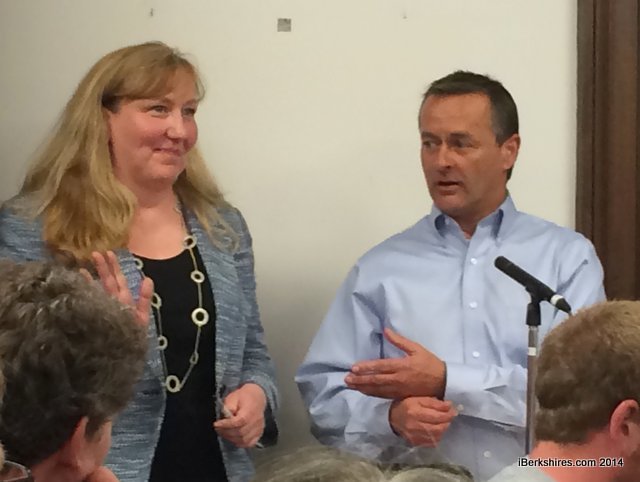 Mollye Wolahan of the Women's Institute for Housing and Economic Development and Elton Ogden of Berkshire Housing Development Corp. appear before the Selectmen on Tuesday.
Mollye Wolahan of the Women's Institute for Housing and Economic Development and Elton Ogden of Berkshire Housing Development Corp. appear before the Selectmen on Tuesday.
